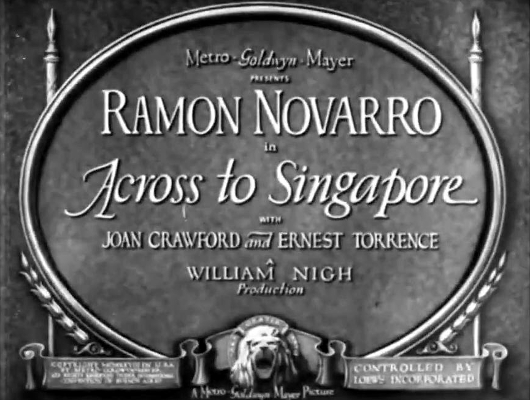
The Best of Everything
Encyclopedia Entry • Films Main
Across to Singapore
1928

Critics' Reviews • Our Reviews • Movie Posters • Lobby and Window Cards • Misc. Images
Click here to see photos from the film.
|
US general release: 4/7/28.
Cast: Ramon Novarro, Joan Crawford (as "Priscilla Crowninshield"), Ernest Torrence, Frank Currier, Dan Wolheim, Duke Martin, Edward Connelly, James Mason, Anna May Wong. Credits: Based on the 1919 novel All the Brothers Were Valiant by Ben Ames Williams. Continuity: E. Richard Schayer. Director: William Nigh. Camera: John Seitz. Editor: Ben Lewis.
Plot Summary: Across to Singapore was the second screen version of Ben Ames Williams' All the Brothers Were Valiant, first filmed in 1923, and later remade in 1953. The plot is motivated by the deadly rivalry between two seafaring brothers, virtuous deckhand Joel Shore (Ramon Novarro) and wicked Captain Mark Shore (Ernest Torrence). Forced into a marriage with Mark, Priscilla Crowninshield (Joan Crawford) tries to be loyal to her husband but falls in love with Joel instead. Things reach a fever pitch when mutinous first mate Finch (James Mason) strands Shore in Singapore and takes Joel and Priscilla prisoner. Mark catches up with his ship and kills the mutineers, but when he realizes that his wife is now deeply in love with his brother, he considerately sacrifices his own life in the climactic melee. ~ Hal Erickson, All Movie Guide
|
Photoplay (1928): Don't try to follow the intricacies of this plot--just keep in mind that the turmoil of villainy and the sea will not overcome either Ramon Novarro or Joan Crawford. Ernest Torrence, as a horny-fisted old salt, dismisses formality and announces his engagement to the girl without consulting her. Crafty Chinese complicate matters with mutiny, dope dens and attempted seduction. Recommended as a stimulant.
Film Daily (1928): Ramon Novarro miscast as tough sea dog. Should have played him up on the Romeo stuff. Joan Crawford petite and always an alluring picture. Ernest Torrence dominates in strong characterization.
Mordaunt Hall in the New York Times (April 30, 1928): Although "Across to Singapore," the present film offering at the Capitol Theatre, has some expertly composed scenes and genuinely clever acting, the story as a whole is frequently artificial and forced and therefore unconvincing. It is a yarn of a mariner's unrequited love and valiant efforts have been made to give it a sea-worthy quality. The title-writer diligently puts into the mouths of the male element his conception of the lingo of the sea, which smacks more often than not of musical comedy. The shallow attempts at fun are often quite feeble and hardly the sort of thing one hopes for in a serious dramatic subject. It is an in-and-out tale, with good points mixed with poor ones in many of its episodes. Priscilla Crowninshield, the heroine, appears on the long voyage to the Far East looking as if she were ready at any moment for a tea party; but, at the same time, during these episodes there is an excellent conception of sailors fighting a storm at sea. Added to this, one of the brothers Shore, from Paradise Cove, Mass., shouts into the gale: "There's a mad sea and a crazy gale challenging us Shores to fight." When a man is washed overboard and Joel Shore, the youngest of the brothers, is about to leap to the rescue, Mark Shore, played by Ernest Torrence, bellows out: "The sea's hungry, she'd rather have two than one." On the other hand there is a scene in a barroom during which both Mr. Torrence and Ramon on Novarro are decidedly competent. But even here the idea of Joel (Mr. Novarro) flipping stones with unerring aim at Mark and a foreign sailor is rather silly. It is also quite stupid when Joel picks up an unconscious man and proceeds to pretend to fight and lay out his victim. Joel is supposed to be lacking in nerve and strength required for the sea, but this youngster endeavors to prove to his older brothers that he is as good as they are. He is superior to them when it comes to winning the affection of the beautiful Priscilla. It is in Singapore that Mark goes to the bad and his ship has to sail without him. Eventually after the return to Paradise Cove, Priscilla decides to go to Singapore to prevail upon Mark to sober up and return home. The Nathan Ross, as the good ship is named, seems to be ready to go out to the Far East at an hour's notice. William Nigh directed this picture from an adaptation of a story by Ben Ames Williams. He does not always give his characters credit for sufficient intelligence and in the announcing of a betrothal one would think that the man in the case would have mentioned something about it to the girl he hoped to marry. At the end of the church service at which this announcement is made, one perceives Joel standing in the aisle, but apparently he does not attract the attention of a soul. Ernest Torrence is splendid as Mark. Mr. Novarro's performance is also quite good. Joan Crawford, who plays Priscilla, is best in those moments when she is natural and is not thinking about turning her eyes for effect.
Jeff Rapsis, Silent Film Music (2013)
It was among the first feature films to star a very young
Joan Crawford, and it was almost lost in the period when Hollywood made
the transition from silent films to soundtracks in the late 1920s. 'Across
to Singapore' (1928), directed by William Nigh, was among the last
silent dramas produced by MGM, then the most prestigious studio in
Hollywood. In addition to up-and-coming female star Joan Crawford, the
film starred A-list actor Ramon Novarro, a heartthrob at the peak of his
popularity, as well as gruff character actor Ernest Torrence. |
If you've seen Across to Singapore and would like to share your review here, please e-mail me. Include a picture of yourself or avatar to accompany your review, as well as a star-rating (with 5 stars the best) and any of your favorite lines from the film.
 Tom C.
(May 2022) Tom C.
(May 2022)Rating:
Across to Singapore (1928) holds a special place in my cinephile heart, as it is the movie that catalyzed my fascination with early Joan Crawford. I was having trouble sleeping one night, so I turned on TCM. In the silent film that was showing, I recognized Ernest Torrence from Steamboat Bill Jr. and Ramon Novarro from The Student Prince in Old Heidelberg. However, what really caught my eye was the young female lead, whom I did not recognize. I was transfixed, not only by her beauty but also her charm. The camera just seemed to love her; the screen sparkled when she was on. When the movie ended, I got on my iPhone, sussed out the film, and then went to the IMDB page for Across to Singapore. When I saw who played the female lead, my jaw hit the ground. Joan Crawford?!? THE Joan Crawford?!? Like any cinema buff, I knew the name, had heard of the book/film (the name of which shall never pass my lips/keyboard), and had seen the psycho-biddy film Baby Jane on TV as a kid. After a little Googling, I became fascinated by her rags-to-riches life story (born in San Antonio, just like my lovely wife), reading long into the night. Across to Singapore (A2S) is a typical Hollywood love triangle. Torrence is Mark Shore, sea captain and oldest of four brothers. Novarro is Joel Shore, the youngest. JC plays Priscilla Crowninshield. She and Joel are young friends on the verge of the transition to lovers. To celebrate the safe return of the older Shore brothers, a celebratory dinner is held with the Crowninshields. Mark has returned from a 2-year voyage and, being no dummy, realizes that in his absence, Priscilla has grown into a lovely young lady. He is immediately smitten (I don't blame him!). It is now that the fathers get involved. Apparently without either Mother Crowninshield or Mother Shore around to slap some sense into the old duffers, they set in motion the conflict that drives the movie. The fathers decide they should announce a betrothal in the morning. What ensues is a struggle between the disparate demands of the heart and familial duty. The Shore brothers soon leave on another voyage, this time including younger brother Joel, who is now deemed old enough to live the life of a salt. At the ship's sailing, Priscilla and Joel have a poignant farewell, as befits two young lovers who must part. However, when Mark Shore tries to plant a smooch on his betrothed, Priscilla recoils. This distresses Mark to the point that he is immediately driven to psychosis (it's only an hour-long movie, no time for lengthy, nuanced descents into madness). One of the crew, Finch, exploits the opportunity to stage a mutiny and has Mark killed---or so he thinks---in a seedy Singapore bar. To complete his treachery, Finch brings Joel home in shackles and accuses him of abandoning Mark in his hour of need. Joel thus resolves to: a) clear his name, b) find and rescue Mark, and c) convince Priscilla to make good her betrothal to his older brother so that Mark may regain his sanity. Joan was not fond of costume dramas (and at the time was embarrassed when the famous Broadway duet of Lunt and Fontanne only knew Joan from her work in A2S). Joan also considered herself as window dressing in this movie. All true perhaps, but I think Joan is fabulous here. In the early comedic scenes with Novarro and Torrence, she's delightful. Her smile is electric. In the heavier scenes toward the end of the film, Joan has a delicacy and moderation in her acting that many silent film heroines lacked. As I've said in other reviews, I think these qualities presaged her superstardom in talkies when combined with her work ethic to master the new medium of sound film. The camera loves Joan and it's not hard to believe that men would go to extremes to win her heart or---nautical pun warning---go off the deep end because of her. We get to see in this movie, for the last time, the young ingenue Joan. After A2S, it's on to Our Dancing Daughters and Joan's name above the title. The A2S Joan is the Joan that fascinates me. Here she is, the charwoman's daughter on the cusp of worldwide fame---before she was Mary Pickford's daughter-in-law, before the Shop-Girl Myth, before Gable, before Adrian, before eyebrows and The Feud, before the post-mortem hatchet job. Overall, heart wins over head, and I give A2S 4 stars. The main cast is excellent. The story is well told, based on the novel All the Brothers Were Valiant. Indeed, I thought the movie better than the book. But, in the final analysis, this movie was the entry point to my interest with early Joan Crawford, and for that I am grateful.
Rating:
Just three films away from making her big splash in the ultra-modern Our Dancing Daughters, also released in 1928, Joan here plays an 1800s lass caught in the middle of some weird psychological drama between two seafaring brothers. As "Priscilla Crowninshield," Joan gets to glow, grin, weep, and shoot a guy down from a top-mast, and she accomplishes every sometimes ludicrous task with a professional ease that shows she was up for anything the studio handed her.
Ramon Novarro, the brother Priscilla loves, is "Joel," the playful kid of the sea-dog family, looked down upon fondly by his older, brawling, tough-guy brothers. (Joan and Novarro look absolutely stunning together, two glowing, vital examples of beauty and onscreen charisma. Their opening scenes on the beach and at dinner in the brothers' home--when Novarro in particular gets to show off his looks and charm--are lighthearted and fun; the two seem natural and comfortable together.)
Plot complications arise when Joel's oldest brother Mark (the rough-hewn, towering Ernest Torrence) decides he loves Priscilla and their fathers promptly announce in church, without Joel or Priscilla's knowledge, that Mark and Priscilla will be wed after the brothers return from their upcoming voyage to Singapore. Joel and Priscilla's exchanged looks of dismay during the announcement are subtly expressive, as is their farewell scene aboard ship the next day, where Priscilla sensually nuzzles the now-reluctant Joel, who feels compelled to remain loyal to his brother.
So far so good in this first third of the film. After this, however, things seem to go a little awry. Brother Mark has noted Priscilla's shipboard reluctance to kiss him goodbye and he soon begins to brood over her (even hallucinating her ghostly presence in a ship doorway. Later, funnily, her face even pops up in the bottom of his glass!). Once the brothers dock in Singapore, Mark starts boozing it up in a brothel, to the shock of the innocent Joel: "You've got to remember Priscilla!" Joel chides, pulling a harlot from Mark's lap. Mark quite rightly orders Joel back to the ship, then stumbles into the night with his newfound Asian floozie (Anna May Wong), only to get jumped by a combination of local toughs and mutinous sailors from his own ship. He disappears and is assumed dead by all except Joel. His ship sails for home without him.
Did I say things seemed to go "a little awry" earlier? Well, at this point the plot ventures beyond "awry" into the "haywire" territory. In short: Once back home, Joel, who's suddenly evolved into a stubble-bearded tough guy himself, now kidnaps Priscilla and forces her to sail back to Singapore with him and the once-mutinous crew. Since she has driven his brother mad, only she can rescue him. Cut to a hilarious title: "Six months in Singapore has made Mark a drink-crazed, half-mad, gibbering derelict." Sure enough, there he is, drinking and gibbering, driving his now live-in Asian floozie mad with his incessant sea chanties. The derelict Mark somehow, though, manages to spot his ship in the harbor and is reunited with brother, Priscilla, et al.
The rest of the film is a blur of dumb brawling: Mark with Joel, Joel with mutinous sailor, Mark with mutinous sailor, good sailors vs. bad sailors. And...why, there's Priscilla in the middle of it all, shooting off a gun she found somewhere! Whew! (I won't try to spoil anything by revealing which brother conveniently gets harpooned in the back during all this brawling...)
In spite of the haphazard latter part of the film, Across to Singapore is partially redeemed by the first third, where Joan and Novarro get to be their charming, attractive selves. It's a pleasure just being able to watch the two of them, despite the ensuing bizarre plot convolutions.
(Side-note: Ben Ames Williams, who wrote the novel upon which this movie was based, also later wrote the novel Leave Her to Heaven, which was made into a psychologically disturbing--and excellent--film starring Gene Tierney in 1945.)
|
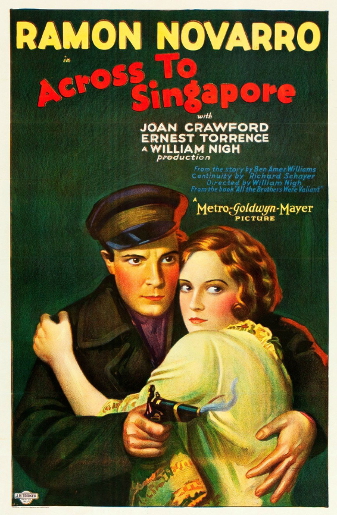
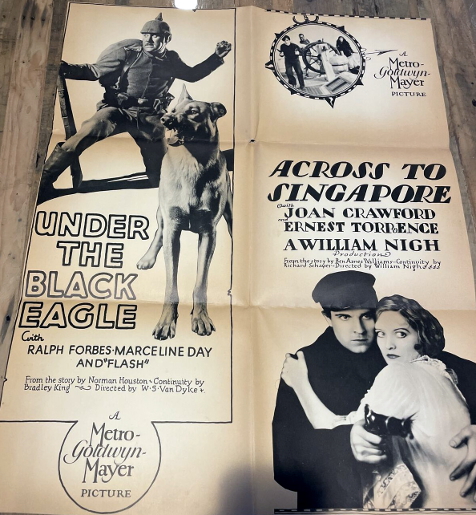
Above: US.
Below: Argentina, Belgium, France, and Sweden.
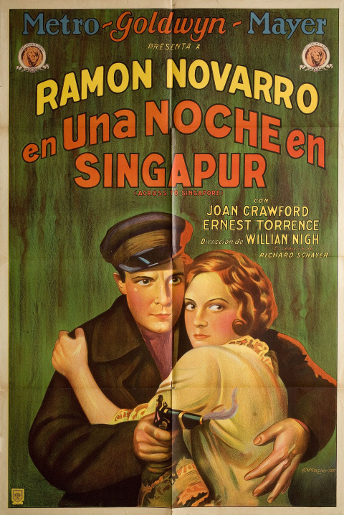
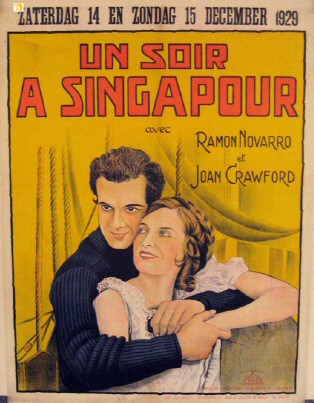
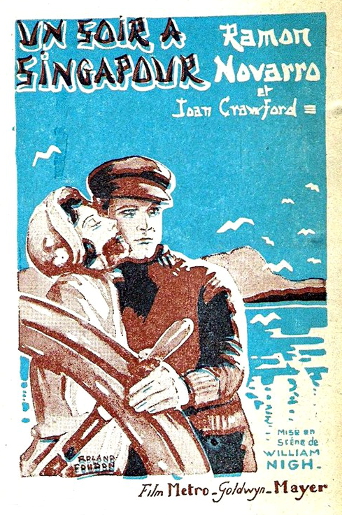
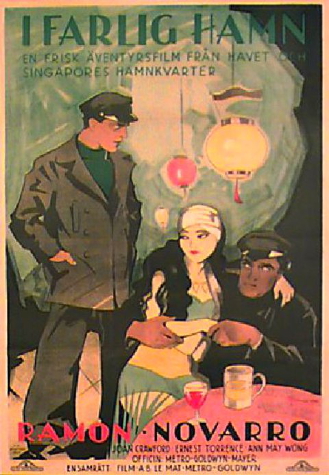


Above: US window cards. Below: US lobby cards.



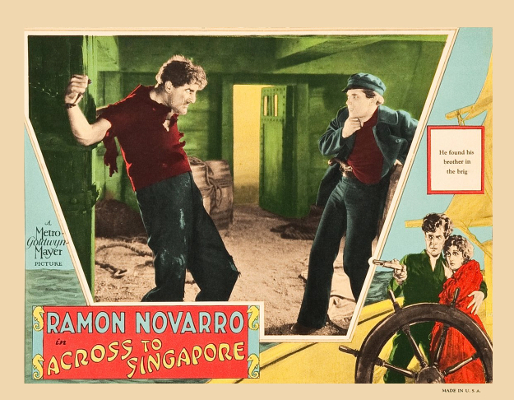
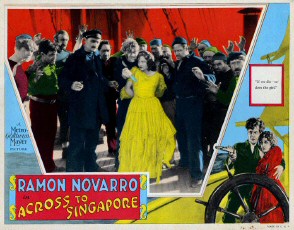

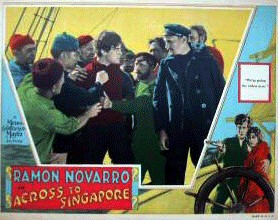
Above: US movie tie-in book (see the Books Related to Joan Movies page for more info); French sheet music; US lantern slide.
Below: Australian daybill and US newspaper ad (Waterloo, Iowa).


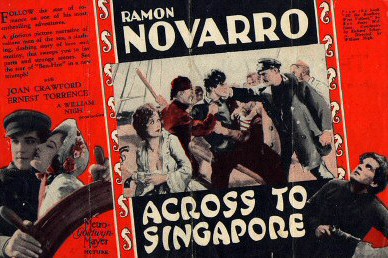

Above: US program.
The Best of Everything
